|
Miscellaneous Dialogs |
|
Different Dialogs available in the UserInterfaces Class (c) 20011 Hermetech International Ltd. |
||
|
|||||
|
Description: Dialog to choose an EasyHL7 Vendor definition installed in a VendorPath. Parameter 1: oVendor (EasyHL7MC40.HL7Vendor) - A properly instantiated HL7Vendor object (see Programming with the HL7 Vendor Object). The object must at least have the VendorPath property set. If the HL7Vendor object has already loaded a Vendor definition (see OpenVendor Method) then that Vendor definition will be selected when the dialog displays. OR Parameter 1: strVendorPath (String) - A full path to a folder where EasyHL7 Vendor definitions are installed. The dialog will be invoked and there will be no "pre selected" vendor definition. OR Parameter 1: strVendorPath (String) - As above Parameter 2: strDefaultVendorID (String) - The VendorID to "pre select" as the default selection.
Return Value: UISelection Object. In the UISelection object returned the HL7DialogResult will either be DialogResult.Ok or DialogResult.Cancel. If DialogResult.Ok then the Value property will contain the following named items:
Screenshot:
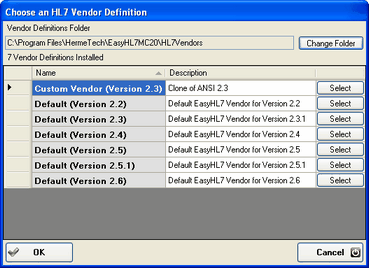 ChooseVendor() Method
Description: Dialog to choose an HL7 Data Type stored in an HL7 Vendor Definition. Parameter 1: objHL7Vendor (EasyHL7MC40.HL7Vendor) - A properly instantiated HL7Vendor object (see Programming with the HL7 Vendor Object). The object must have a vendor definition opened (see OpenVendor). Parameter 2: strDefaultDataType (String) - If passed the data type will be "pre-selected" if it exists. An empty string "" is permissible. OR Parameter 1: strDefaultDataType (String) - If passed the data type will be "pre-selected" if it exists. An empty string "" is permissible. If this calling convention is used then the HL7Vendor object used when creating your UserInterfaces object must have a vendor definition opened (see OpenVendor and UserInterfaces).
Return Value: UISelection Object. In the UISelection object returned the HL7DialogResult will either be DialogResult.Ok or DialogResult.Cancel. If DialogResult.Ok then the Value property will contain the following named items:
Screenshot:
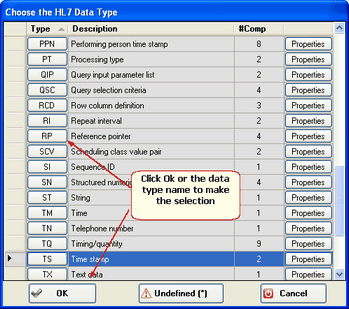 ChooseHL7DataType() Method
Description: Dialog to choose an internal HL7 Table stored in an EasyHL7 Vendor definition . Parameter 1: objHL7Vendor (EasyHL7MC40.HL7Vendor) - A properly instantiated HL7Vendor object (see Programming with the HL7 Vendor Object). The object must have a vendor definition opened (see OpenVendor). Parameter 2: intDefaultTableID (Integer) - If passed the selected HL7 Table ID will be "pre-selected" if it exists. 0 is permissible. OR Parameter 1: objHL7Vendor (EasyHL7MC40.HL7Vendor) - A properly instantiated HL7Vendor object (see Programming with the HL7 Vendor Object). The object must have a vendor definition opened (see OpenVendor).
Return Value: UISelection Object. In the UISelection object returned the HL7DialogResult will either be DialogResult.Ok or DialogResult.Cancel. If DialogResult.Ok then the Value property will contain the following named items:
Screenshot:
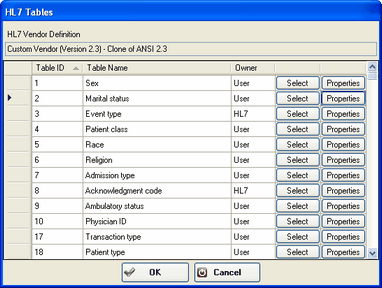 ChooseHL7Table() Method
Description: Dialog to allow users to add/edit/delete HL7 data types in an EasyHL7 Vendor definition. Parameter 1: strDefaultDataType (String) - If passed the selected HL7 data type will be "pre-selected" if it exists. An empty string ("") is permissible. The UserInterfaces object must have been created with an HL7Vendor object with a vendor definition opened (see OpenVendor).
Return Value: System.WIndows.Forms.DialogResult - Will be either DialogResult.Ok, DialogResult.Cancel or DialogResult.Abort. If not DialogResult.Ok then you can check the IsError and LastError properties to see what went wrong. Also you can check the UpdatesWereMade property to determine the user made changes in the dialog.
Screenshots:
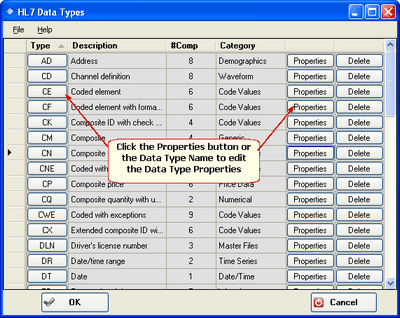 ManageHL7DataTypes() Method
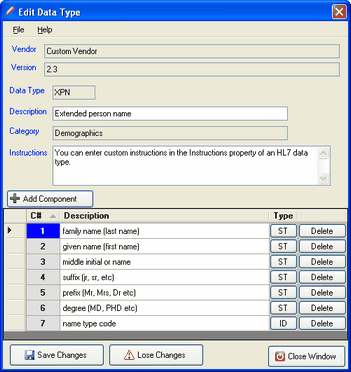 Editing a particular data type
Description: Dialog to allow users to create/edit/delete internal HL7 tables within an EasyHL7 Vendor definition. Parameter 1: objHL7Vendor (EasyHL7MC40.HL7Vendor) - A properly instantiated HL7Vendor object (see Programming with the HL7 Vendor Object). The object must have a vendor definition opened (see OpenVendor). Parameter 2: intDefaultTableID (Integer) - If passed the selected HL7 Table ID will be "pre-selected" if it exists. 0 is permissible. OR Parameter 1: objHL7Vendor (EasyHL7MC40.HL7Vendor) - A properly instantiated HL7Vendor object (see Programming with the HL7 Vendor Object). The object must have a vendor definition opened (see OpenVendor).
Return Value: System.WIndows.Forms.DialogResult - Will be either DialogResult.Ok, DialogResult.Cancel or DialogResult.Abort. If not DialogResult.Ok then you can check the IsError and LastError properties to see what went wrong. Also you can check the UpdatesWereMade property to determine the user made changes in the dialog.
Screenshots:
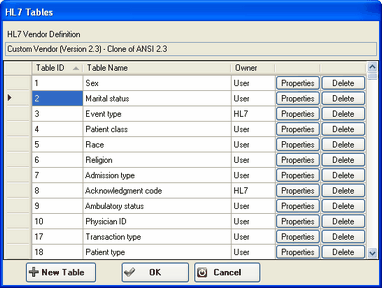 ManageHL7Tables() Method
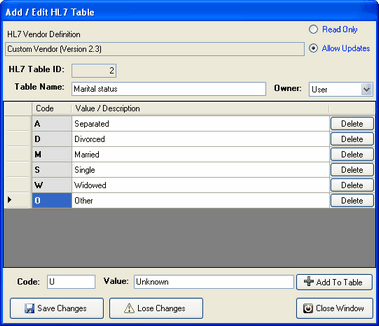 Editing an HL7 Internal Table
Method: ShowVendorPathSelection() Description: Dialog to allow users to select a Vendor Path and (optionally) install the Default EasyHL7 Vendor Definitions . Parameters: NONE. The initial path selected will be the VendorPath property of the HL7Vendor object used when creating the UserInterfaces object.
Return Value: System.WIndows.Forms.DialogResult - Will be either DialogResult.Ok, DialogResult.Cancel or DialogResult.Abort. If not DialogResult.Ok then you can check the IsError and LastError properties to see what went wrong. The VendorPath property will contain their path selection. Also you can check the UpdatesWereMade property to determine if the user made changes in the dialog.
Screenshots:
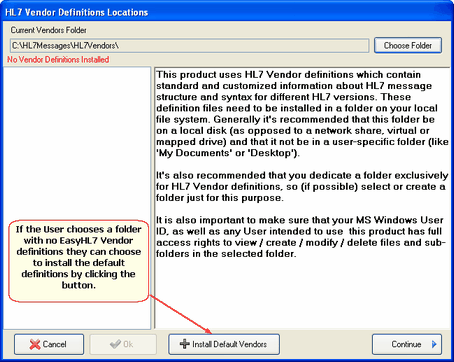 ShowVendorPathSelection() Method
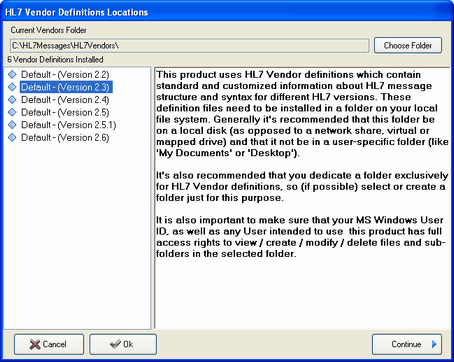 ShowVendorPathSelection() Method (Vendors Installed)
|